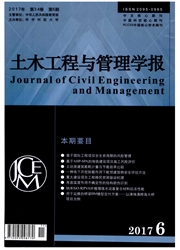

 中文摘要:
中文摘要:
建立三维有限元模型,分别对钢筋混凝土梁柱节点和新型钢管混凝土柱-钢骨混凝土梁节点的力学性能进行研究。钢骨采用格构式构造,即采用角钢代替梁中纵向钢筋,用钢量不会增加很多,用薄钢板代替箍筋,角钢可以和混凝土很好的协同工作,节点不采用传统的加强环式连接,而是将其直接穿过柱拉通。结果表明,新型节点可很好传递梁端弯矩和剪力,初始刚度大,且延性好,有很长的屈服平台,屈服后承载力下降不多,抗震性能优越。破坏时柱钢管应力较小,没有出现屈服,柱内核心混凝土大部分处于受压状态,应力较小。节点域和柱变形极小,说明该种节点整体性很好,刚度大。破坏时塑性角外移,避免了节点域的脆性破坏,符合强节点,弱杆件的抗震设计原则。
 英文摘要:
英文摘要:
In this paper, the mechanical behavior of new type composite joints was studied by the three-dimensional finite element method. The joints consist of concrete-filled square steel tubular column and steel skeleton reinforced concrete beam. The result shows that the joint has excellent integrality, large initial stiffness, good seismic resistance performance, favorable ductility deformation capacity, and can easily transmit beam moment. Also, the joint shows long yield platform and has very little decrease of the capacity after yield. The column pipe shows small stress and there is almost no yielding after damage. Most parts of concrete in the core of the column are compressed, but the stress is very small. Both panel zones and column show little deformation. In the damage process, plastic hinge moves away from joint where brittle failure is avoided. Thus, the joint is strong enough for earthquake-resistance.
 同期刊论文项目
同期刊论文项目
 同项目期刊论文
同项目期刊论文
 期刊信息
期刊信息
